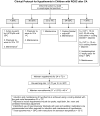How I cool children in neurocritical care
- PMID: 20146026
- PMCID: PMC3221013
- DOI: 10.1007/s12028-010-9334-5
How I cool children in neurocritical care
Abstract
Brain injury is the leading cause of death in our pediatric ICU [Au et al. Crit Care Med 36:A128, 2008]. Clinical care for brain injury remains largely supportive. Therapeutic hypothermia has been shown to be effective in improving neurological outcome after adult ventricular-arrhythmia-induced cardiac arrest and neonatal asphyxia, and is under investigation as a neuroprotectant after cardiac arrest and traumatic brain injury in children in our ICU and other centers. To induce hypothermia in children comatose after cardiac arrest we target 32-34 degrees C using cooling blankets and intravenous iced saline as primary methods for induction, for 24-72 h duration with vigilant re-warming. The objective of this article is to share our hypothermia protocol for cooling children with acute brain injury.
Figures
Similar articles
-
Double cooling for pericardial tamponade and cardiac arrest after rewarming in neonatal asphyxia.Resuscitation. 2013 Jul;84(7):e83-4. doi: 10.1016/j.resuscitation.2013.03.020. Epub 2013 Mar 22. Resuscitation. 2013. PMID: 23528679 No abstract available.
-
[ Hypothermia after resuscitation. Better prognosis for cool patients].MMW Fortschr Med. 2011 Nov 17;153(46):20. doi: 10.1007/BF03369059. MMW Fortschr Med. 2011. PMID: 22145237 German. No abstract available.
-
Prolonged mild therapeutic hypothermia versus fever control with tight hemodynamic monitoring and slow rewarming in patients with severe traumatic brain injury: a randomized controlled trial.J Neurotrauma. 2015 Apr 1;32(7):422-9. doi: 10.1089/neu.2013.3197. Epub 2015 Jan 8. J Neurotrauma. 2015. PMID: 25099730 Free PMC article. Clinical Trial.
-
Induced hypothermia and fever control for prevention and treatment of neurological injuries.Lancet. 2008 Jun 7;371(9628):1955-69. doi: 10.1016/S0140-6736(08)60837-5. Lancet. 2008. PMID: 18539227 Review.
-
[Hypothermia for intracranial hypertension].Ann Fr Anesth Reanim. 2009 Apr;28(4):365-70. doi: 10.1016/j.annfar.2009.03.001. Epub 2009 Apr 5. Ann Fr Anesth Reanim. 2009. PMID: 19346097 Review. French.
Cited by
-
Outcome prediction by motor and pupillary responses in children treated with therapeutic hypothermia after cardiac arrest.Pediatr Crit Care Med. 2012 Jan;13(1):32-8. doi: 10.1097/PCC.0b013e3182196a7b. Pediatr Crit Care Med. 2012. PMID: 21499174 Free PMC article.
-
Targeted Temperature Management in Pediatric Central Nervous System Disease.Curr Treat Options Pediatr. 2015 Mar 1;1(1):38-47. doi: 10.1007/s40746-014-0008-y. Curr Treat Options Pediatr. 2015. PMID: 26042193 Free PMC article.
-
24 vs. 72 hours of hypothermia for pediatric cardiac arrest: A pilot, randomized controlled trial.Resuscitation. 2018 May;126:14-20. doi: 10.1016/j.resuscitation.2018.02.008. Epub 2018 Feb 14. Resuscitation. 2018. PMID: 29454009 Free PMC article. Clinical Trial.
-
Fever control and application of hypothermia using intravenous cold saline.Pediatr Crit Care Med. 2012 Jan;13(1):80-4. doi: 10.1097/PCC.0b013e3181fe27c7. Pediatr Crit Care Med. 2012. PMID: 21037507 Free PMC article.
-
Current status and prognostic factors of paediatric arterial ischaemic stroke in China: a study protocol for Chinese Paediatric Ischaemic Stroke Registry (CPISR).BMJ Open. 2025 Jun 18;15(6):e093718. doi: 10.1136/bmjopen-2024-093718. BMJ Open. 2025. PMID: 40533220 Free PMC article.
References
-
- Au AK, Carcillo JA, Clark RS, Bell MJ. Brain injury contributes to greater than 90% of deaths in previously healthy children in the PICU. CCM. 2008;36:A128.
-
- Adelson PD, Ragheb J, Kanev P, et al. Phase II clinical trial of moderate hypothermia after severe traumatic brain injury in children. Neurosurgery. 2005;56:740–54. discussion -54. - PubMed
-
- Fink EL, Clark RSB, Kochanek PM, Watson RS. Mild therapeutic hypothermia in a cohort of patients surviving cardiac arrest. CCM. 2007;35:A97.
-
- Association AH. 2005 American Heart Association (AHA) guidelines for cardiopulmonary resuscitation (CPR) and emergency cardiovascular care (ECC) of pediatric and neonatal patients: pediatric advanced life support. Pediatrics. 2006;117:e1005–28. - PubMed
-
- Adelson PD, Bratton SL, Carney NA, et al. Guidelines for the acute medical management of severe traumatic brain injury in infants, children, and adolescents. Chapter 14. The role of temperature control following severe pediatric traumatic brain injury. Pediatr Crit Care Med. 2003;4:S53–5. - PubMed
Publication types
MeSH terms
Grants and funding
LinkOut - more resources
Full Text Sources
Medical


